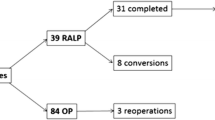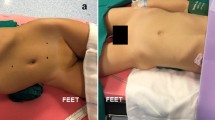Abstract
We aimed to evaluate the safety and efficacy of RALP for UPJO in a heterogeneous pediatric population. The medical records of all patients with UPJO who underwent RALP over the last 6 years and completed at least 6 months of follow-up, were retrospectively reviewed. Data included age, sex, laterality, weight, preoperative and postoperative ultrasound and renal scintigraphy results, operation time, complications, length of hospital stay. We separately examined two groups: low-weight children (< 10 kg) and those who underwent RALP after failed pyeloplasty. One hundred patients with a median age of 18 months (range 2–216) underwent RALP. The median weight was 10 kg (range 4–90). The median operative time, including docking and console time, was 75 min (range 40–183). The median hospital stay was one day (range: 1–3). Ninety-eight percent of the patients showed improvement or stable hydronephrosis on postoperative imaging, with a better drainage curve on dynamic radionuclide scans. In two patients, the hydronephrosis worsened. One patient's ipsilateral UVJ was obstructed, and the other patient's UPJO recurred. The operative time was shorter in the low-weight group (p < 0.001), but the length of hospital stay and success rate were not different. Neither the hospital stay nor the success rate of redo RALP patients differed significantly from a control group of primary RALP patients. Our data show that RALP might be utilized as a universal approach in pediatric patients with UPJO.


Similar content being viewed by others
Data availability
Not applicable.
Code availability
Not applicable.
References
Atug F, Woods M, Burgess SV et al (2005) Robotic assisted laparoscopic pyeloplasty in children. J Urol 174(4):1440–1442
Monn MF, Bahler CD, Schneider EB, et al (2013) Trends in robot-assisted laparoscopic pyeloplasty in pediatric patients. J Urol 8(6):1336–1341
Lee RS, Retik AB, Borer JG, Peters CA (2006) Pediatric robot assisted laparoscopic dismembered pyeloplasty: comparison with a cohort of open surgery. J Urol 175(2):683–687
Boysen WR, Gundeti MS (2017) Robot-assisted laparoscopic pyeloplasty in the pediatric population: a review of technique, outcomes, complications, and special considerations in infants. Pediatr Surg Int 33(9):925–935
Freilich DA, Penna FJ, Nelson CP et al (2010) parental satisfaction after open versus robot assisted laparoscopic pyeloplasty: results from modified glasgow children’s benefit inventory survey. J Urol 183(2):704–708
Esposito C, Masieri L, Blanc T et al (2021) Robot-assisted laparoscopic pyeloplasty (RALP) in children with complex pelvi-ureteric junction obstruction (PUJO): results of a multicenter European report. World J Urol 39(5):1641–1647
Lindgren BW, Hagerty J, Meyer T, Cheng EY (2012) Robot assisted laparoscopic reoperative repair for failed pyeloplasty in children: a safe and highly effective treatment option. J Urol 188(3):932–937
Hemal AK, Mishra S, Mukharjee S, Suryavanshi M (2008) Robot assisted laparoscopic pyeloplasty in patients of ureteropelvic junction obstruction with previously failed open surgical repair. Internat J Urol 15(8):744–746
Jacobson DL, Shannon R, Johnson E, et al (2019) Robot-assisted laparoscopic reoperative repair for failed pyeloplasty in children: an updated series. J Urol 20(5): 1005–1011
Davis TD, Burns AS, Corbett ST, Peters CA (2016) Reoperative robotic pyeloplasty in children. J Pediatr Urol 12(6):394.e1-394.e7
Asensio M, Gander R, Royo GF, Lloret JF (2015) pyeloplasty in children: Is robot-assisted laparoscopic reoperative repair feasible? J Pediatr Urol 11(2):6916
Oderda M, Calleris G, Allasia M et al (2017) Robot-assisted laparoscopic pyeloplasty in a pediatric patient with horseshoe kidney: surgical technique and review of the literature. Urologia 84(1):55–60
Nayyar R, Gupta NP, Hemal AK (2010) Robotic management of complicated ureteropelvic junction obstruction. World J Urol 28(5):599–602
Chertin B, Pollack A, Koulikov D et al (2006) Conservative treatment of uretero-pelvic junction obstruction in children with antenatal diagnosis of hydronephrosis: lessons learned after 16 years of follow up. Eur Urol 49(4):734–739
Kafka I, Kocherov S, Jaber J, Chertin B (2019) Pediatric robotic-assisted laparoscopic pyeloplasty (RALP): does weight matter?. Pediatr Surg Int 35(3): 391–396
Anderson JC, Hynes W (1949) Retrocaval ureter; a case diagnosed pre-operatively and treated successfully by a plastic operation. Br J Urol 21(3):209–214
Andreoni C, Gattas N, Araujo M et al (2004) Transmesocolic approach: faster and safe for laparoscopic surgery on the left side. J Urol, suppl 171:318
Cisek LJ, Roth DR, Gonzal ET, Jones EA (2004) Pediatric laparoscopic pyeloplasty. J Endourol, suppl 6:171–177
Sameer M, Aghababian A, Sahar E et al (2021) Primary vs redo robotic pyeloplasty: a comparison of outcomes. J Pediatr Urol 17(4):528.e1-528.e7
Kawal T, Srinivasan AK, Shrivastava D, et al (2018) Pediatric robotic-assisted laparoscopic pyeloplasty: does age matter? J Pediatr Urol 14: 540.e1–540.e6
Dothan D, Raisin G, Jaber J, Kocherov S, Chertin B (2020) Learning curve of robotic-assisted laparoscopic pyeloplasty (RALP) in children: how to reach a level of excellence? J Robot Surg 15(1):93–97
Chertin B, Pollack A, Koulikov D et al (2009) Does renal function remain stable after puberty in children with prenatal hydronephrosis and improved renal function after pyeloplasty? J Urol 182(4S):1845–1848
Acknowledgements
Kocherov S and Chertin B have equally contributed to this manuscript.
Funding
Not applicable.
Author information
Authors and Affiliations
Corresponding author
Ethics declarations
Conflict of interest
Sarit Cohen, David Dothan, Galia Raisin, Jawdat Jaber, Stanislav Kocherov, and Boris Chertin declare that they have no conflict of interest.
Ethics approval
We received approval from the institute review board.
Consent to participate
Not applicable.
Consent for publication
Not applicable.
Additional information
Publisher's Note
Springer Nature remains neutral with regard to jurisdictional claims in published maps and institutional affiliations.
Rights and permissions
About this article
Cite this article
Cohen, S., Raisin, G., Dothan, D. et al. Robotic-assisted laparoscopic pyeloplasty (RALP), for ureteropelvic junction obstruction (UPJO), is an alternative to open pyeloplasty in the pediatric population. J Robotic Surg 16, 1117–1122 (2022). https://doi.org/10.1007/s11701-021-01341-1
Received:
Accepted:
Published:
Issue Date:
DOI: https://doi.org/10.1007/s11701-021-01341-1




